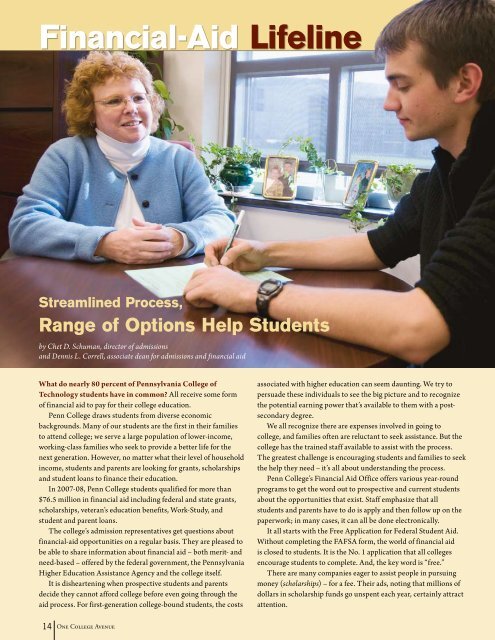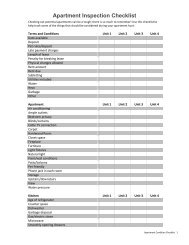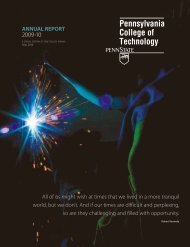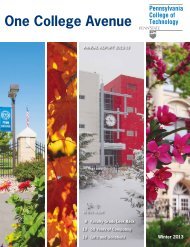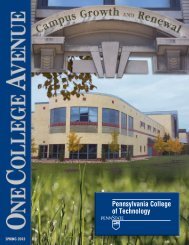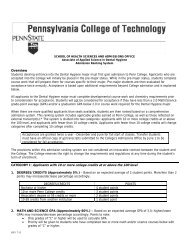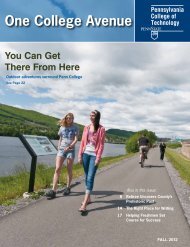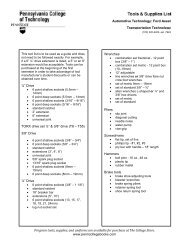Winter 2008-09 - Pennsylvania College of Technology
Winter 2008-09 - Pennsylvania College of Technology
Winter 2008-09 - Pennsylvania College of Technology
- TAGS
- pennsylvania
- pct.edu
You also want an ePaper? Increase the reach of your titles
YUMPU automatically turns print PDFs into web optimized ePapers that Google loves.
Financial-Aid Lifeline<br />
Streamlined Process,<br />
Range <strong>of</strong> Options Help Students<br />
by Chet D. Schuman, director <strong>of</strong> admissions<br />
and Dennis L. Correll, associate dean for admissions and financial aid<br />
What do nearly 80 percent <strong>of</strong> <strong>Pennsylvania</strong> <strong>College</strong> <strong>of</strong><br />
<strong>Technology</strong> students have in common? All receive some form<br />
<strong>of</strong> financial aid to pay for their college education.<br />
Penn <strong>College</strong> draws students from diverse economic<br />
backgrounds. Many <strong>of</strong> our students are the first in their families<br />
to attend college; we serve a large population <strong>of</strong> lower-income,<br />
working-class families who seek to provide a better life for the<br />
next generation. However, no matter what their level <strong>of</strong> household<br />
income, students and parents are looking for grants, scholarships<br />
and student loans to finance their education.<br />
In 2007-08, Penn <strong>College</strong> students qualified for more than<br />
$76.5 million in financial aid including federal and state grants,<br />
scholarships, veteran’s education benefits, Work-Study, and<br />
student and parent loans.<br />
The college’s admission representatives get questions about<br />
financial-aid opportunities on a regular basis. They are pleased to<br />
be able to share information about financial aid – both merit- and<br />
need-based – <strong>of</strong>fered by the federal government, the <strong>Pennsylvania</strong><br />
Higher Education Assistance Agency and the college itself.<br />
It is disheartening when prospective students and parents<br />
decide they cannot afford college before even going through the<br />
aid process. For first-generation college-bound students, the costs<br />
14 One <strong>College</strong> Avenue<br />
associated with higher education can seem daunting. We try to<br />
persuade these individuals to see the big picture and to recognize<br />
the potential earning power that’s available to them with a postsecondary<br />
degree.<br />
We all recognize there are expenses involved in going to<br />
college, and families <strong>of</strong>ten are reluctant to seek assistance. But the<br />
college has the trained staff available to assist with the process.<br />
The greatest challenge is encouraging students and families to seek<br />
the help they need – it’s all about understanding the process.<br />
Penn <strong>College</strong>’s Financial Aid Office <strong>of</strong>fers various year-round<br />
programs to get the word out to prospective and current students<br />
about the opportunities that exist. Staff emphasize that all<br />
students and parents have to do is apply and then follow up on the<br />
paperwork; in many cases, it can all be done electronically.<br />
It all starts with the Free Application for Federal Student Aid.<br />
Without completing the FAFSA form, the world <strong>of</strong> financial aid<br />
is closed to students. It is the No. 1 application that all colleges<br />
encourage students to complete. And, the key word is “free.”<br />
There are many companies eager to assist people in pursuing<br />
money (scholarships) – for a fee. Their ads, noting that millions <strong>of</strong><br />
dollars in scholarship funds go unspent each year, certainly attract<br />
attention.


